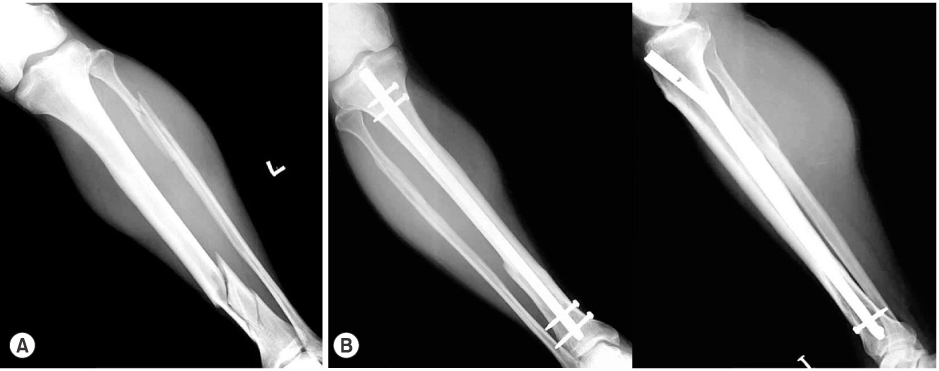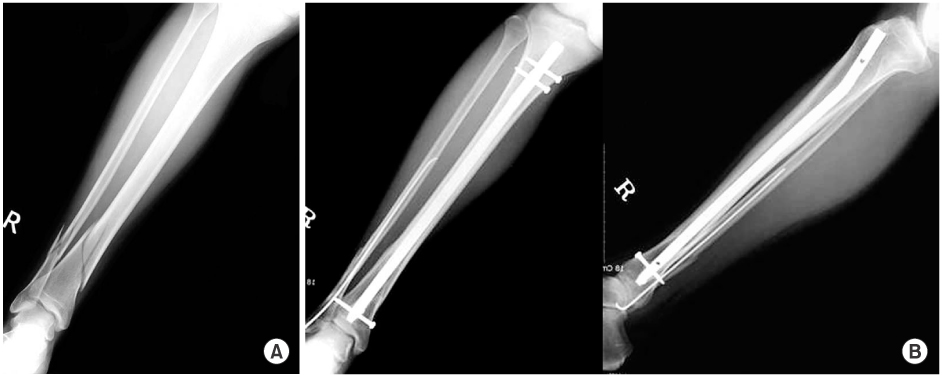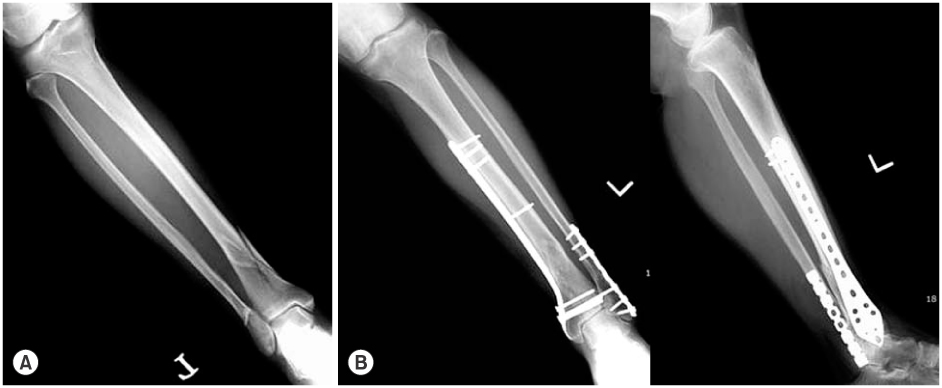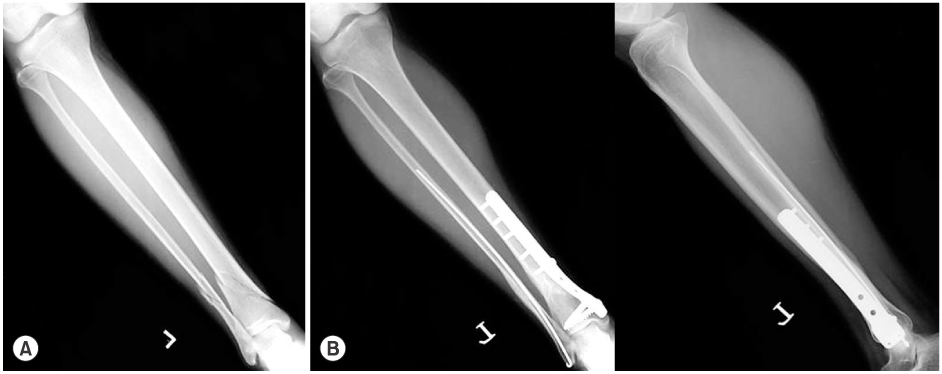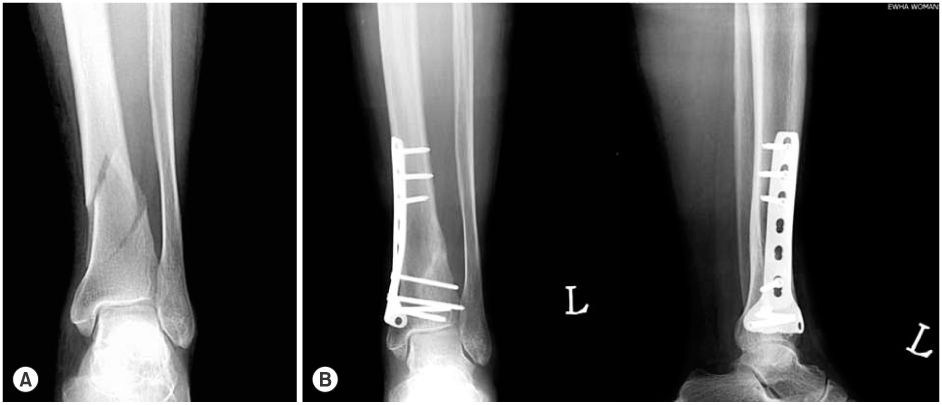J Korean Fract Soc.
2007 Apr;20(2):154-160. 10.12671/jkfs.2007.20.2.154.
Comparative Study of Intramedullary Nailing and Plate for Metaphyseal Fractures of the Distal Tibia
- Affiliations
-
- 1Department of Orthopedic Surgery, Seoul Red-Cross Hospital, Seoul, Korea.
- 2Department of Orthopedic Surgery, College of Medicine, Ewha Womans University, Seoul, Korea. yjdos@ewha.ac.kr
- KMID: 2295573
- DOI: http://doi.org/10.12671/jkfs.2007.20.2.154
Abstract
- PURPOSE
To compare the radiological and clinical results between intramedullary nailing and plate fixation in the treatment of distal tibial fractures.
MATERIALS AND METHODS
19 cases of distal tibial metaphyseal fractures within 4 cm of the ankle joint line were enrolled. Ten patients were treated with interlocking intramedullary nail and the others with plate and screws.
RESULTS
The mean union time was 14 weeks in nailing group and 16 weeks in plate group. The average angulation in AP view was 4.1 degrees in nailing group and 3.1 degrees in plate group. The average angulation in lateral view was 1.7 degrees in nailing group and 2.7 degrees in plate group. The rotational deformity was 2.8 degrees in nailing group and 1.7 degrees in plate group in average. There was no implant failure and soft tissue problem.
CONCLUSION
There was no difference in clinical and radiological results between intramedullary nailing and plate in the treatment of the distal tibial fractures and, considering the preservation of the soft tissue, the intramedullary nails are a reliable method for managing distal metaphyseal fractures of the tibia.
Keyword
MeSH Terms
Figure
Cited by 1 articles
-
A Comparison of the Results between Intramedullary Nailing and Minimally Invasive Plate Osteosynthesis in Distal Tibia Fractures
Chul-Hyun Park, Chi-Bum Choi, Bum-Jin Shim, Dong-Chul Lee, Oog-Jin Shon
J Korean Orthop Assoc. 2014;49(4):285-293. doi: 10.4055/jkoa.2014.49.4.285.
Reference
-
1. Bone LB. Fractures of the tibial plafond. The pilon fracture. Orthop Clin North Am. 1987; 18:95–104.2. Dillin L, Slabaugh P. Delayed wound healing, infection, and nonunion following open reduction and internal fixation of tibial plafond fractures. J Trauma. 1986; 26:1116–1119.
Article3. Dogra AS, Ruiz AL, Thompson NS, Nolan PC. Diametaphyseal distal tibial fractures-treatment with a shortened intramedullary nail: a review of 15 cases. Injury. 2000; 31:799–804.
Article4. Egol KA, Weisz R, Hiebert R, Tejwani NC, Koval KJ, Sanders RW. Does fibular plating improve alignment after intramedullary nailing of distal metaphyseal tibia fractures? J Orthop Trauma. 2006; 20:94–103.
Article5. Fan CY, Chiang CC, Chuang TY, Chiu FY, Chen TH. Interlocking nails for displaced metaphyseal fractures of the distal tibia. Injury. 2005; 36:669–674.
Article6. Gorczyca JT, McKale J, Pugh K, Pienkowski D. Modified tibial nails for treating distal tibia fractures. J Orthop Trauma. 2002; 16:18–22.
Article7. Hahn D, Bradbury N, Hartley R, Radford PJ. Intramedullary nail breakage in distal fractures of the tibia. Injury. 1996; 27:323–327.
Article8. Im GI, Tae SK. Distal metapyseal fractures of tibia: a prospective randomized trial of closed reduction and intramedullary nail versus open reduction and plate and screws fixation. J Trauma. 2005; 59:1219–1223.9. Kim YS, Chung PH, Hwang CS, Kang S, Kim JP, Lee HM. Interlocking intramedullary nailing in distal tibial metaphyseal fractures. J Korean Fract Soc. 2005; 18:269–274.
Article10. Martin JS, Marsh JL, Bonar SK, DeCoster TA, Found EM, Brandser EA. Assessment of the AO/ASIF fracture classification for the distal tibia. J Orthop Trauma. 1997; 11:477–483.
Article11. Merchant TC, Dietz FR. Long-term follow-up after fractures of the tibial and fibular shafts. J Bone Joint Surg Am. 1989; 71:599–606.
Article12. Mosheiff R, Safran O, Segal D, Liebergall M. The unreamed tibial nail in the treatment of distal metaphyseal fractures. Injury. 1999; 30:83–90.
Article13. Na HY, Park YJ, Ko SH, Choe WS, Lee YS, Yoon KD. Comparative analysis of interlocking IM nailing and LC-DCP fixation in the treatment of distal tibial fracture. J Korean Soc Fract. 2002; 15:152–158.
Article14. Oestern HJ, Tscherne H. Pathophysiology and classification of soft tissue injuries associated with fractures. In : Tscherne H, Gotzen L, editors. Fracture with soft tissues injuries. Berlin: Springer-Verlag;1984. p. 1–9.15. Oh CW, Kyung HS, Park IH, Kim PT, Ihn JC. Distal tibia metaphyseal fractures treated by percutaneous plate osteosynthesis. Clin Orthop Relat Res. 2003; 408:286–291.
Article16. Redfern DJ, Syed SU, Davies SJ. Fractures of the distal tibia: minimally invasive plate osteosynthesis. Injury. 2004; 35:615–620.
Article17. Richmond J, Colleran K, Borens O, Kloen P, Helfet DL. Nonunions of the distal tibia treated by reamed intramedullary nailing. J Orthop Trauma. 2004; 18:603–610.
Article18. Robinson CM, McLauchlan GJ, McLean IP, Court-Brown CM. Distal metaphyseal fractures of the tibia with minimal involvement of the ankle. Classification and treatment by locked intramedullary nailing. J Bone Joint Surg Br. 1995; 77:781–787.
Article19. Teeny SM, Wiss DA. Open reduction and internal fixation of tibial plafond fractures: variables contributing to poor results and complications. Clin Orthop Relat Res. 1993; 292:108–117.20. Zelle BA, Bhandari M, Espiritu M, Koval KJ, Zlowodzki M. Evidence-Based Orthopaedic Trauma Working Group. Treatment of distal tibia fractures without articular involvement: systematic review of 1125 fractures. J Orthop Trauma. 2006; 20:76–79.
Article
- Full Text Links
- Actions
-
Cited
- CITED
-
- Close
- Share
- Similar articles
-
- Interlocking Intramedullary Nailing in the Distal Metaphyseal Fractures of the Tibia
- Interlocking Intramedullary Nailing in Distal Tibial Metaphyseal Fractures
- Comparative Analysis of Minimally Invasive Plate Osteosynthesis Using Periarticular Plate and Intramedullary Nailing in Distal Tibial Metaphyseal Fractures
- Results of Intramedullary Nailing for Distal Metaphyseal Intra-Articular Fractures of Tibia
- Comparison of the Results between Intramedullary Nailing and Plate Fixation for Distal Tibia Fractures

